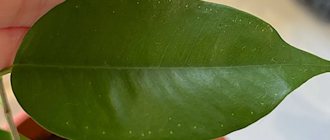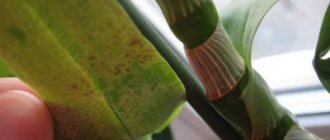It is worth highlighting the main points that cause yellowing of Monstera leaves.
Excess or lack of moisture
An abundance of moisture causes problems with the condition of the plant's leaves . It all starts with the roots, which rot, despite the fact that Monstera removes some of the water through the mouth on its own. To eliminate rotting, you need to reduce the amount of water during watering until the soil dries completely. In particularly advanced cases, replanting the plant and removing damaged roots helps. Monstera is watered after transplantation three days later.
Nutritional deficiencies
Monstera is a tropical plant, so it is important to feed it during growth to compensate for the lack of nutrients. To do this, plant growers adhere to a specially designed soil fertilization schedule.
- In spring - every 2 weeks, fertilize the soil with fertilizers.
- In summer - fertilize the soil with the addition of humus.
Incorrect soil selection
If you purchase a plant in a store, be sure to replant the Monstrela. The soil that is used for plants for sale is filled with a large amount of fertilizers and growth stimulants. If you leave a flower in such conditions, it deteriorates and the leaves turn yellow. When replanting, choose slightly acidic soil or suitable soil from specialists on store shelves.
Dry air
The problem occurs in winter due to the operation of central heating batteries.
Air humidity is reduced to 25%, while for Monstera it is recommended to maintain 60-70%. The problem is solved by spraying with water at room temperature. In some cases, it can be boiled and cooled. Monstera tolerates direct spraying well . The method fits well with the watering schedule.
Incorrect lighting
The organization of light directly affects the condition of Monstera leaves. The plant loves sunlight, but direct rays are dangerous for it. It is necessary to place the pot so that there is enough sun, but without direct lighting on the flower. Windows facing east or west are suitable.
Temperature
Monstera grows well and develops from 16 to 25 degrees Celsius . In other cases, the plant stops growing or grows slowly, the leaves turn yellow and deteriorate. In winter, it is worth maintaining the temperature and not letting it drop below 12 degrees.
Diseases and pests
Monstera is a strong plant and is rarely attacked by pests. But in poor conditions, the main enemies of Monstera are spider mites and mealybugs. They select the undersides of the leaf or its axils. After the attack, the plant stops growing and the leaves turn yellow.
Reasons for yellowing of monstera leaves
The leaves of Monstera selectively turn yellow, which means that it is enough to reduce the watering regime to cope with this problem. When the room temperature is about 16 degrees, it is reduced. Watering in winter is recommended at intervals of 10–15 days. In this case, the water is allowed to stand additionally for at least 24 hours and heated to room temperature. After watering, any remaining water that has leaked into the pan can be drained. If this is not done, the monstera roots will begin to rot and the leaves will turn yellow.
It happens that the plant becomes yellow and lethargic due to a lack of sunlight. During the winter months, it is better to move the pot to a south-facing window sill. Experienced gardeners install lighting lamps near the monstera. In summer, you should choose a more shaded place for this plant, where there are no bright rays. In its natural environment it grows under tall trees. With an abundance of light, the plant easily gets burned. Therefore, you should not place it in summer on southern windows or take it out into the sun without prior preparation.
Leaf blades change color when overmoistened. This phenomenon occurs when the flower is constantly flooded. The cause of yellowing may also be due to an incorrectly selected substrate. The soil must be nutritious and have high breathability. The plant's roots will have difficulty breathing in heavy soil. If the owner floods the monstera, it will begin to wither and rot.
An option would be to transplant into a container with new soil. Dark and yellow leaves are cut off. If only the edges of the sheet have changed color, then only the damaged elements are removed. Damage to monstera leaves can occur due to infestation by harmful insects. The leaves also turn yellow due to a lack of moisture in the soil and the plant itself. In this case, it should be moistened with wet expanded clay scattered on a tray. A container with a plant is placed on it. If the pot is too large, it is recommended to humidify it by placing containers of water in the room.
Plant treatment
If a pest is detected, you must try to get rid of it using folk remedies (infusions of onion peels, tobacco or calendula, crushed garlic, a solution of tar or laundry soap). They are less radical and harmful both to the flower itself and to the people living in the apartment. The measure is justified when there are few insects and the plant has not had time to suffer much. Otherwise, it is better to use synthetic insecticides.
Timely treatment will help preserve Monstera
In order for the Monstera to please the owner with its appearance, it is necessary to establish proper care. First of all, it is removed from the draft and protected from accidental damage. You need to carefully select new soil for replanting the vine. The wrong composition is detrimental to the flower. The plant requires regular feeding and watering, diffuse lighting and spraying of leaves.
Establishing proper care
Carefully thought out care will ensure the long life of the flower, as well as its abundant growth. To do this, you just need to adhere to the basic principles:
Healthy and lush flower
- proper lighting, namely shaded areas;
- optimal air humidity - at least 60%;
- moderate watering;
- careful selection of soil and sterilization before planting a flower;
- regular fertilizing;
- compliance with quarantine for new plants and timely treatment.
By periodically inspecting house plants, you can recognize an incipient disease in the shortest possible time or organize care for your monstera. Only if the basic principles are observed, Monstera will delight you with an abundance of large and beautiful green leaves.
Why do monstera leaves turn black and what to do with the plant
Monstera's leaves often turn yellow if it is not satisfied with the amount of light or moisture.
The plant is usually placed on or near a windowsill on the southwest or southeast side so that all leaves receive enough light. The northern window has much less natural light.
If additional illumination with an electric lamp is not provided, the plant will lose its rich green color and growth will slow down. But direct sunlight is also dangerous - it can burn.
Leaves turn yellow if the air in the room is dry. On a hot day, the monstera does not need to be watered more often: the roots consume less moisture; they need to be sprayed with clean warm water and wiped with a damp soft cloth.
An air humidifier can save the situation; a pot with a plant can be placed on a tray with wet expanded clay or simply placed around a container of water.
Some gardeners wrap aerial roots with wet cloths at high temperatures.
If you water the monstera too often in winter when the air temperature is low, its leaves will turn yellow. Yellowing and loss of turgor will result from placing the pot in a draft. If the soil in the pot is too heavy or it has become muddled because it has not been changed for a long time, the result will be the same - yellowing, slow growth, discolored spots may appear on the leaves.
Temperature adjustment
The beginning of the heating season in apartments often affects the condition of plants. Monstera has yellow tips on the leaves, reflecting its actual position. Damage occurs from dry air in the room, excess heat flow from heating sources, if the plant is located close to the radiator. The temperature needs to be adjusted and normal conditions created. If the radiator burns oxygen, and the vine loves fresh air, you will need to periodically ventilate the premises. At this time, regularly monitor the soil to see if there is enough moisture there. The window sill is constantly heated, which makes the earth dry faster.
The owner constantly:
- regulates the watering mode;
- removes flower pots from too hot places;
- more often carries out overhead spraying.
During the winter season, additional care for aerial roots is required:
- they are lowered into water;
- create bags with pre-moistened moss;
- Instead of attachments, supports made from wet strands are used.
They perform a dual function:
- support the trunk;
- transfer moisture.
The roots must receive constant, comprehensive nutrition. Earth lumps will prevent free access to beneficial substances and will not allow the plant to breathe freely.
Watering
Before the next watering, the moisture must be completely absorbed. If the top layer of soil is wet, stagnation will form due to the new portion of liquid. The soil at the bottom of the flowerpot clumps into a lump, and the roots rot. Then the yellow leaves are removed, and the monstera is watered less often. For irrigation, use settled or boiled water.
Note! Excessive watering leads to the proliferation of fungal flora, yellowing of leaves and death of the flower.
In summer, the plant is watered more often. If there is not enough moisture, the lower leaves turn yellow. They sink to the bottom and yellow spots may appear. In such cases, the flower is watered 1-2 times a week in small portions. On hot days, the green part is additionally sprayed with a spray bottle. Aerial roots can be placed in a container of water. With good care, Monstera produces large flowers that resemble feces.
Important! If the soil has an unpleasant odor, watering should be reduced . The monstera is left alone for 1-2 weeks. During this period, the substrate must dry completely.
Yellowing of leaves followed by drying out
- When monstera foliage not only turns yellow, but also dries , it means your vine is too hot. As a rule, this problem occurs with the beginning of the heating season, when the room temperature rises and the humidity becomes much lower. The same can be observed in the summer heat if the flower is exposed to the rays of the hot sun. The recipe in this case is simple: the vine needs to be moved to a cooler place, away from sunny windows and heating appliances.
- The leaves of the plant may not turn yellow entirely, but only along the edges . Such changes are observed when the monstera is “starving” or the container is too tight. To fix the problem, transplant the flower into a larger pot and feed it with special fertilizer for decorative foliage flowers.
- Yellowing, warping, drying out and falling foliage may be a sign of mealybug or spider mite infestation . To revive the monstera, you need to wipe the plant with a soft cloth or sponge dipped in soapy water. Then wash the plant with warm water and subsequently spray regularly. In case of severe damage, you will have to resort to the help of special chemicals.
Reasons for yellowing of monstera leaves
This state of the plant can be due to a number of reasons, namely:
- If all the leaves of a plant turn yellow and then gradually turn pale, this can only mean that there is too much light for the plant. Monstera loves shaded places, so if it gets direct sunlight, the flower must be covered with a curtain or moved away from the window.
- If, on the contrary, there is no sufficient lighting, then the vine may completely shed its foliage. If the monstera is in a too dark place, then it must be moved closer to the windows. Otherwise, the plant may leave only a few leaves on the top and discard the rest.
- If yellowness and brown spots appear on the lower leaves of the plant, but the young foliage remains a rich green color, then it is worth reconsidering the amount of watering. It may not be enough for the normal development of the plant and it is worth increasing the amount of moisture.
- If, along with the appearance of yellowing, the leaves of the flower wither and dry out, this may indicate an excess of moisture and damage to the root system of the plant. In this case, it is worth reducing watering and cutting off wilted leaves. If the situation is critical, then you can try to replant the plant into new soil, and during the replanting process you need to remove the rotten roots. The monstera does not need to be watered for three to four days.
- Another factor that provokes the appearance of yellowness may be a lack of nutrients. To remove this reason, you can feed it with ash or nitrogen fertilizers.
If the leaves turn yellow and dry out
In cases where the foliage does not just turn yellow, but gradually dries out, this may indicate too high an air temperature and low humidity. Do not forget that the liana is a tropical plant. Most often, Monstera owners encounter a similar problem with the onset of the heating season. The same situation can happen again in the summer, when the plant is exposed to direct sunlight. In order to protect the flower, it must be moved to a cooler place.
Sometimes the leaves of a plant turn yellow only at the edges. This problem occurs if the flower pot is too small for it or the plant does not receive the required amount of nutrients. In such cases, urgent transplantation into a larger container and fertilizing with suitable fertilizers is necessary.
Another cause of yellow leaves can be pests: mealybugs or spider mites. To resuscitate the flower, the foliage and trunk must be washed with soapy water. Then rinse with clean water, and then carry out regular treatment for prevention. If the plant is severely affected, then special chemicals will have to be used.
Yellowness and wilting of monstera leaves
This problem most often arises in the autumn-winter period, if at low temperatures the owners continue to water the vine abundantly. In such situations, the life processes of the flower are inhibited, and the leaves gradually dry out. To restore the normal development of the plant, it is necessary to adjust the temperature in the room and check for problems with the level of air humidity. Watering volumes should be reduced.
Prevention and care measures
To prevent diseases and pest infestations, follow the following rules:
- buy plants in a specialized store - the likelihood of purchasing a diseased monstera is much lower, and you can get advice on care from a specialist;
- observe quarantine for new flowers for at least a week, only after that place the pots next to others;
- periodically wash the leaves with Epin or Zircon;
- From time to time, disinfect the soil with a weak solution of potassium permanganate and fertilize the soil;
- Provide good care to the plant in accordance with its requirements.
Inspect your flower every week to spot any signs of problems as early as possible. The unpretentious monstera has a strong immune system if it receives enough minerals, water and light. Follow simple rules for caring for it and do not forget that they are different in summer and winter.










